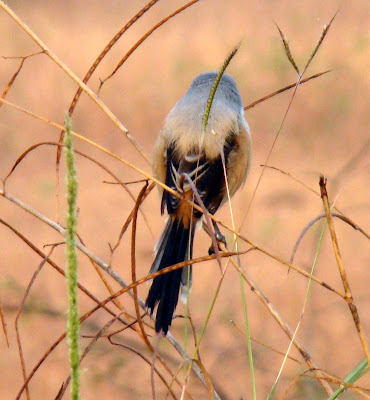These birds will catch your attention because of the black
eye patches they have which look like a robbers mask! I find them quite camera
friendly; they will boldly sit while you are clicking away to your heart’s
content.
Long-tailed or Rufous-Backed Shrike
Lanius schach
Size 25 cm M/F alike
Characteristics :
The Long-Tailed shrike is one of the commonest of the shrikes, here in Pune, and seen quite often, as soon you are outside
the main city areas. The picture above was taken on our morning walks near the
airport, where a small swamp had developed because of some drain water
collecting (sadly the place is now under construction and out of bounds for us
and also a whole variety of birds that we used to see there). It has a grey
head, rufous rump, rufous lower back (hence the name) and underparts. The black
band across the eyes is of-course typical of the species. These are predators;
their hooked beaks are a testimony to that. In fact they are ruthless hunters
and will hunt any small animals, including birds, decapitating them and
impaling the skulls on acacia thorns, which has earned them the nickname of 'The Executioner' in the local language!. Our little serial-killer has another talent, it can mimic a whole
range of voices, not just bird calls! We thought just pet parakeets could do
it!
Distribution : it
is a widespread resident bird found all across the sub-continent and Myanmar
upto 3000 m into the Himalayas.
Food : small
animals like mice and lizards, and large insects.
Breeding: it
nests in small trees. Making a cup shaped nest of twigs, grass etc it lays 3-6
spotted greenish eggs. Both parents participate in chick rearing.
Grey Shrike
Lanius meridionalis
Size 25 cm M/F alike
The above picture of the bird sitting on top of a Champa
bush was taken in Aurangabad, in the premises of the Ajanta Caves – it made
quite a picturesque sight. It has a silver-grey colour with black wing quills
and a white patch which is called ‘mirror’ and a thick and curved hawk-like
beak. It has similar characteristics, eating and breeding habits to the
rufous-backed shrikes. It prefers more arid areas than the rufous-backed.
NEXT Page
NEXT Page




No comments:
Post a Comment